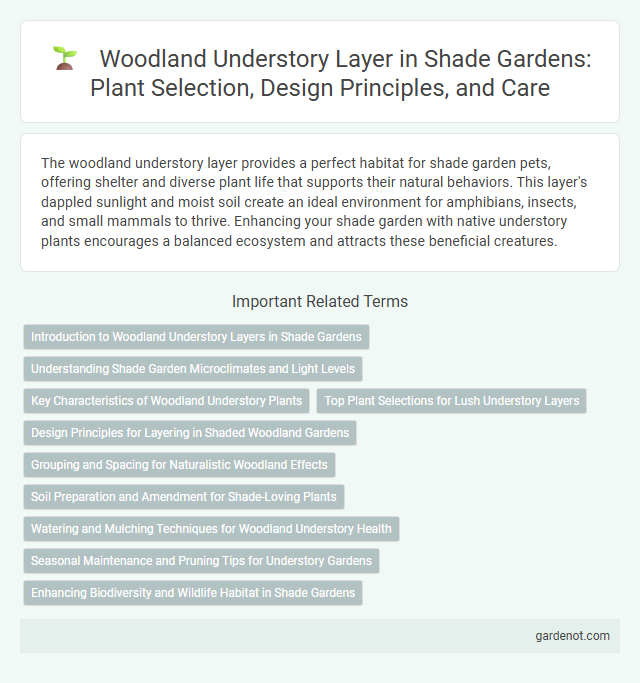The woodland understory layer provides a perfect habitat for shade garden pets, offering shelter and diverse plant life that supports their natural behaviors. This layer's dappled sunlight and moist soil create an ideal environment for amphibians, insects, and small mammals to thrive. Enhancing your shade garden with native understory plants encourages a balanced ecosystem and attracts these beneficial creatures.
Introduction to Woodland Understory Layers in Shade Gardens
Woodland understory layers in shade gardens consist of shade-tolerant plants that thrive beneath the forest canopy, providing diverse textures and colors. Common species include ferns, hostas, and trilliums, which create a thriving ecosystem by enhancing soil moisture retention and supporting local wildlife. Integrating understory plants improves garden biodiversity and contributes to a natural, layered landscape design.
Understanding Shade Garden Microclimates and Light Levels
The woodland understory layer in shade gardens experiences filtered sunlight, creating microclimates with varying light intensities essential for shade-tolerant plants. Understanding these light levels allows gardeners to select native ferns, hostas, and shade-loving perennials that thrive in dappled or low-light conditions. Soil moisture and humidity in this microenvironment also influence plant health, making irrigation and mulching critical for maintaining optimal growth.
Key Characteristics of Woodland Understory Plants
Woodland understory plants thrive in low-light conditions, exhibiting shade tolerance and slow growth rates that adapt them to the filtered sunlight beneath forest canopies. These plants often have broad, thin leaves to maximize photosynthesis and a strong root system for nutrient absorption in nutrient-poor soils. Many understory species display seasonal growth patterns and provide critical habitats for wildlife, contributing to forest biodiversity.
Top Plant Selections for Lush Understory Layers
Top plant selections for a lush woodland understory layer include shade-tolerant perennials like hostas, ferns, and bleeding hearts, which thrive in low-light conditions beneath a tree canopy. Native groundcovers such as wild ginger and foamflower provide dense, moisture-loving foliage that supports biodiversity. Incorporating spring ephemerals like trilliums ensures seasonal interest and ecological balance within the shade garden ecosystem.
Design Principles for Layering in Shaded Woodland Gardens
Design principles for layering in shaded woodland gardens prioritize creating a naturalistic structure by combining diverse understory plants with varying heights, textures, and foliage colors. Incorporating shade-tolerant species such as ferns, hostas, and native wildflowers enhances biodiversity while establishing distinct vertical layers beneath the tree canopy. Strategic placement ensures efficient use of limited light, promoting healthy growth and maintaining ecological balance within the shade garden ecosystem.
Grouping and Spacing for Naturalistic Woodland Effects
Grouping shade-loving perennials and shrubs in clusters of three to five plants mimics the natural woodland understory, enhancing visual depth and ecological balance. Proper spacing allows air circulation and light penetration, crucial for healthy growth while preventing overcrowding that can lead to disease. Incorporating varied plant heights and textures within these groups creates a layered, naturalistic effect that supports biodiversity and aesthetic appeal.
Soil Preparation and Amendment for Shade-Loving Plants
Soil preparation for a woodland understory layer requires amending with organic matter such as leaf mold, compost, and well-aged manure to enhance moisture retention and nutrient availability for shade-loving plants. Incorporating a 2-3 inch layer of mulch helps regulate soil temperature and suppress weeds, mimicking natural forest floor conditions. Regular soil testing guides adjustments in pH, ideally maintaining a slightly acidic range of 5.5 to 6.5 to support species like hostas, ferns, and astilbes thriving in shaded environments.
Watering and Mulching Techniques for Woodland Understory Health
Effective watering techniques for the woodland understory prioritize deep, infrequent watering to encourage strong root growth and prevent fungal diseases common in shaded environments. Applying a 2-3 inch layer of organic mulch, such as shredded leaves or bark, helps retain soil moisture, regulate temperature, and suppress weed competition while gradually enriching the soil. Consistent monitoring of soil moisture levels ensures plants receive adequate hydration without waterlogging, promoting a thriving, healthy woodland understory layer.
Seasonal Maintenance and Pruning Tips for Understory Gardens
Regular seasonal maintenance in woodland understory gardens involves removing dead or diseased branches in early spring before new growth begins, promoting healthy development. Pruning should focus on thinning dense areas to improve air circulation and light penetration, especially in late winter or after flowering of understory plants like dogwood or viburnum. Mulching with organic matter during fall enhances soil moisture retention and temperature regulation, supporting the delicate root systems beneath the shade canopy.
Enhancing Biodiversity and Wildlife Habitat in Shade Gardens
The woodland understory layer in shade gardens plays a crucial role in enhancing biodiversity by providing diverse plant species that support various wildlife habitats. Native shrubs, ferns, and shade-tolerant perennials create microhabitats for insects, birds, and small mammals, contributing to a balanced ecosystem. Incorporating this layer increases ecological complexity, promotes pollination, and supports natural pest control in shaded garden environments.
Woodland understory layer Infographic

 gardenot.com
gardenot.com